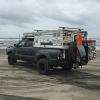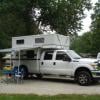....was wondering about this the last few days. My wife and I live in Wyoming but bailed to the San Diego area the last 10 days for some warmth and So. Cal. beach camping (great time). While camped at Carlsbad for a couple days I managed to run my 2 Fiamm 80Ah deep cycle batteries low enough that I wondered if anything was wrong with them. I have a 100w solar panel on the roof with the ZAMP 30A controller, and a Dometic 110 liter frig which we keep set at about 4 (average cooling). I had a 24 hour period where I didn't start my truck, which means that all charging was coming from the panel. We've camped off the grid for days where I didn't start the truck, and the batteries have performed flawlessly. We must have put a load on them this time, because on the second day they drained down low enough that the compressor on the frig kept starting and stopping, and the red LED error light on the frig indicated an inadequate power supply. When we relocated to a new campsite the next day, driving the truck plus the solar panel seemed to top off the batteries fine. I did have the batteries checked at a truck repair shop, and they look ok for now. They're about 2.5 years old.
Anyway, I started looking online for type 24 batteries in case I needed to replace them, and found that there are slight differences in sizing....? Isn't the purpose of a group # to ensure that the battery will fit into the compartment/space? Four Wheel built a pretty tight space for my two batteries, and I'm not sure if any new batteries that might differ by a 1/4 inch or whatever in length or width would fit into that area.
Anyone else run into this?

















